Daily Updates from the 2024 International AIDS Conference


Daily Updates from the 25th International AIDS Conference
Check back each day for amfAR-related news from the conference and updates on HIV cure research and other breakthroughs.
Click here for an overview of amfAR’s contributions to AIDS 2024, including a comprehensive calendar of presentations, sessions, and workshops.
July 26, 2024

Program Communications Manager
Goodbye, AIDS 2024
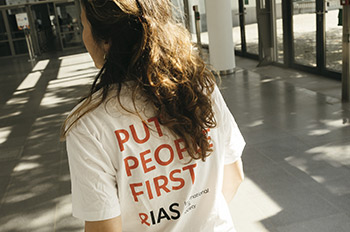
And that’s a wrap! It was a packed conference with plenty of exciting research developments and community-led movements, including the second Berlin Patient: what appears to be another successful HIV cure through stem cell transplantation. Plus, three previously successful cured individuals—Marc Franke, Adam Castillejo, and Paul Edmonds—were present and spoke at the conference.
There is plenty to dissect and discuss and I look forward to providing a more thorough analysis soon, but for now I wanted to share a couple of the themes that I observed while here in Munich.
For one: long-acting injectables. Of course, the results of the PURPOSE 1 lenacapavir trial was probably the biggest news out of AIDS 2024, but long-acting agents for treatment, as well, were a hot topic both in sessions and in informal discussion throughout the conference. There will be plenty of work in order to scale these new medicines around the world, but they represent an exciting step forward.
And on that note, choice was another theme. It’s clear that there is not one single prevention or treatment tool that works for everyone. And as research provides more and more options, the key to ending AIDS is going to be providing equitable access to a multitude of options—long-acting injectables, oral PrEP, condoms, etc.—to everyone and letting them make a decision not just based on what is available or affordable, but based on what is right for them. This goes for treatment options for people living with HIV as well.
A darker theme was the rising tide of the anti-gender movement and its likelihood to roll back progress of the last four decades. And more broadly, continued funding is on everyone’s minds. Governments around the world are signaling their intention to scale back contributions to programs that have had a lasting impact on bringing infection rates down and treatment rates up. But until there is a cure for everyone, that progress is not permanent and to pull back at such a critical moment would have disastrous results indeed.
To all the researchers who presented their work, to the activists who spoke up, and to the policy and decision makers who listened to both: thank you.

Program Communications Manager
TREAT Asia Director Receives Special Commendation
This morning, amfAR VP and TREAT Asia director Dr. Annette Sohn received a special commendation from the IAS for her work as co-editor-in-chief of the Journal of the International AIDS Society.
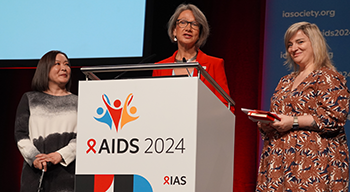
July 24, 2024

Program Communications Manager
Robert Carr Research Award
The steering committee of the RISE study, co-sponsored by amfAR, accept the prestigious Robert Carr Research Award in the Global Village. Dr. Jennifer Sherwood, amfAR Director of Research, Public Policy (third from right) and Alana Sharp (far right) are the study’s lead authors.
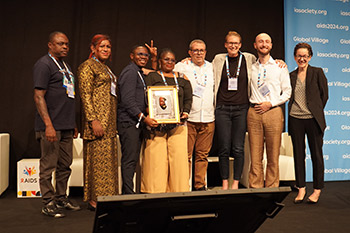

Program Communications Manager
Groundbreaking Study Results: Seventh Individual Most Likely Cured; Twice-a-Year Injectable PrEP Effective for Women and Girls
Arguably the most hotly anticipated session of the whole conference kicked off Wednesday. Researchers presented, for the first time ever, results from a landmark study testing a twice annual injectable PrEP and a new potential HIV cure case, among other innovations selected specifically by AIDS 2024 co-chairs Sharon Lewin, Christoph Spinner, and Andriy Klepikov.
The success of the PURPOSE 1 trial had already been reported, but hundreds of conference attendees packed the plenary hall to watch Linda-Gail Bekker, director of the Desmond Tutu HIV Center, present full data. More than 2,000 cisgender women and girls in Africa participated in the study of a new, twice-a-year injectable PrEP. Not one of them contracted HIV during the study and, in fact, the study was so successful that the blinded phase was ended early and study participants who’d been using oral PrEP were given the option to switch to lenacapavir, the injectable. As Bekker presented, adherence levels were high and adverse effects were mostly minor; as Bekker finalized her presentation she was met with a standing ovation and shouts of approval from the crowd.
We’ll now have to await the results of the PURPOSE 2 trial, which will test lenacapavir in cisgender men, trans women and men, and nonbinary individuals. It won’t be until this trial has concluded that the regulatory process can begin to bring the medication to the market.
Also during the session, Christian Gaebler of Charité – Universitätsmedizin Berlin presented study results on “the next Berlin patient.” Yet another potential HIV cure case from the same city in which the first ever HIV cure—that of the late Timothy Ray Brown—took place. The subject of this new potential cure (who has chosen to remain anonymous) has achieved a total sustained HIV remission for more than five years. He is a white male born in 1964 and was diagnosed with HIV in 2009 and then with acute myeloid leukemia in 2015.
The procedure used with the next Berlin Patient is yet another stem cell transplant and, thus, not a viable option for the vast majority of the nearly 40 million people living with HIV. But his case is unique in that, unlike most other successful stem cell transplant HIV cures, his donor has only one copy of the CCR5-delta32 mutation that renders a person almost completely immune to HIV, rather than two. It will require some further study to determine to full ramifications of this case, but it could open the door to a cure for many more people who already require a stem cell transplant for the treatment of cancer; while only about 1% of people with northern European ancestry have two copies of the CCR5 mutation, as many as 16% have one copy.
What’s harder to convey is the feeling of excitement in the room at this session. The results of the lenacapivir study are truly a landmark and it felt like watching history in the making. In order to have the fullest effect possible, the injection will need to be made available at a reasonable price all around the world. That’s likely going to take some pushing, but for now it’s an incredibly jovial mood throughout the halls at AIDS 2024.
For more information about curing HIV, click here.

Program Communications Manager
Elizabeth Taylor Human Rights Award
Manisha Dhakal accepts the Elizabeth Taylor Human Rights Award on the plenary stage at AIDS 2024 alongside The Elizabeth Taylor AIDS Foundation‘s Robert Suttle. Dhakal leads the Blue Diamond Society which advocates on behalf of LGBTQ+ people in Nepal and played an instrumental role in the country becoming the second in Asia to recognize same sex marriage earlier this year..
The Elizabeth Taylor Human Rights Award is presented biennially at the International AIDS Conference and is supported by amfAR in memory of our Founding International Chairman, Dame Elizabeth Taylor.
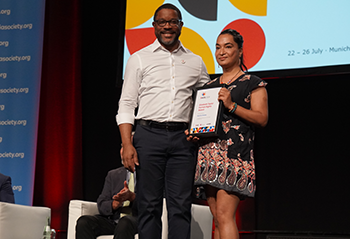
July 23, 2024

Vice President and Director, TREAT Asia
Peer Review Workshop
As co-editor-in-chief of Journal of the International AIDS Society (JIAS), I co-led a workshop for 200 participants on how to conduct a peer review of a scientific manuscript with the JIAS editorial teams. (Unfortunately, the other co-editor-in-chief of the journal, amfAR Program Advisory Council member Dr. Ken Mayer, could not attend).
The peer review process helps to ensure that scientific reports are externally vetted before being published. The workshop sought to build the capacity of early-stage investigators from around the world to engage in this key step in academic research.

Program Communications Manager
Opening Session: Calls to Action
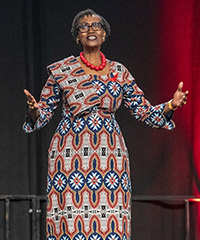
In a packed hall at Messe München, AIDS 2024’s opening session was a resounding call to action, beginning with a moment of silence marking the continued rise in attacks on frontline healthcare workers around the world. According to the World Health Organization, 85% of the 616 confirmed attacks on frontline healthcare workers this year have taken place in Ukraine and Gaza. A series of speakers then proceeded to call out direct threats from around the world to the ongoing response to the HIV epidemic.
Drawing a protracted standing ovation, AIDS 2024 regional co-chair Andriy Klepikov of Ukraine lamented the impact of the ongoing war in his country on the region’s already strained HIV response. “Only half of people living in our region are on antiretroviral therapy, nowhere near the global target of 95%,” he noted.
Noting that he was the first trans man ever invited to present during the opening session at an International AIDS Conference, Uganda’s Jay Mulucha risked his life in order to speak out against new legislation prohibiting homosexuality in the country. He spoke of the dire circumstances faced by queer people in his country, noting that, while international sanctions are working, funding no longer going to the Ugandan government needs to be directed to LGBTQ+ organizations within Uganda.
UNAIDS Executive Director Winnie Byanyima also condemned her home country Uganda’s new legislation and called directly on Gilead Sciences, the maker of injectable treatment lenacapavir, to license the drug to generic manufacturers in order to make it available and affordable in middle- and low-income countries.
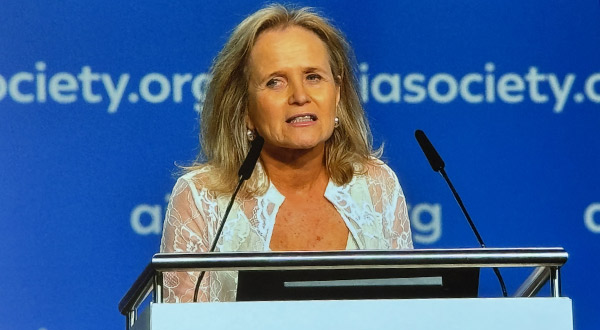
Directly referenced or not, the recurring theme of the night was that despite challenges coming from all directions, now is not the time to let off the gas. International AIDS Society president and conference chair Prof. Sharon Lewin spoke on three direct threats to the ongoing HIV response: the rise in populist government movements, the rollback of civil liberties globally, and the rapid spread of misinformation leading to cuts to global health funding.
In what appeared to be a response to these calls for continued commitment to the global HIV response, German Chancellor Olaf Scholz was the last speaker to take the dais; he appears to be the first leader of the host country to speak at the International AIDS Conference since 2010. Chancellor Scholz reaffirmed Germany’s commitment to supporting the Global Fund to Fight AIDS, Tuberculosis and Malaria. “I would like to call on other donors for stronger support,” he said, without mentioning any other supporters of global public health by name.
July 22, 2024

Chief Executive Officer
Supporting a Cure for HIV: A Round-Table Discussion
I was invited to participate in a round-table discussion this morning to discuss a proposal by The AIDS Fonds of the Netherlands to establish a mission-driven venture fund to support the development of a cure for HIV. Their idea is to focus on the scalability and accessibility of a cure by incentivizing and conducting research on a cure in the global south. Their dream is to bring a cure to market in the south by 2035.
It was a closed-door invitation only meeting that utilized Chatham House rules so we were specifically asked not to share the names of participating organizations or attribute quotes to any individuals, however, we are free to share the contents of the meetings. There was a broad consensus among attendees that the global south is badly underrepresented in cure research, particularly Africa. Building capacity for cure research in the region is an increasing focus of some organizations such as The Gates Foundation and the NIH. However, without a better understanding of where cure research is heading, it’s hard to devise plans for a scalable cure without knowing what that cure will ultimately look like.
It was a good 3-hour meeting, but I’m personally skeptical of what a fund like this can add, unless it can bring additional currently untapped resources to the search for a cure.

Program Communications Manager
UNAIDS Annual Report Released
This morning, on what is officially Day 1 of AIDS 2024, UNAIDS released its annual report on the state of the HIV epidemic; the findings are a mixed bag. Thirty-one million people around the world–the most in history–are now receiving HIV treatment, but that means 9.3 million still lack access to care and one person still dies every minute of AIDS-related causes.
Additionally, progress continues to fall short of 2025 targets. World leaders have pledged to reduce new HIV infections to less than 370,000 by that year, but 2023 numbers show that HIV infections continue at a rate more than three times higher than that target, at 1.3 million. In fact, new HIV infections are on the rise in three regions globally: the Middle East and North Africa, Eastern Europe and Central Asia, and Latin America.
Funding also continues to shrink; UNAIDS reports that total resources available for HIV in 2023 totaled $129.8 billion (U.S.), a drop of 5% from 2022.
July 21, 2024

Program Communications Manager
HIV Cure Session
An exciting and inspiring moment during today’s pre-conference HIV cure session: all three successful cure patients who’ve chosen to make their identities public–Adam Castillejo (the London Patient), Marc Franke (the Düsseldorf Patient), and Paul Edmonds (the City of Hope Patient)–spoke onstage together about their experiences. Edmonds likened the experience of sharing his name to that of his coming out, but all three agreed they’d gone public hoping their stories would inspire researchers and people living with HIV to continue to fight for a cure for everyone.
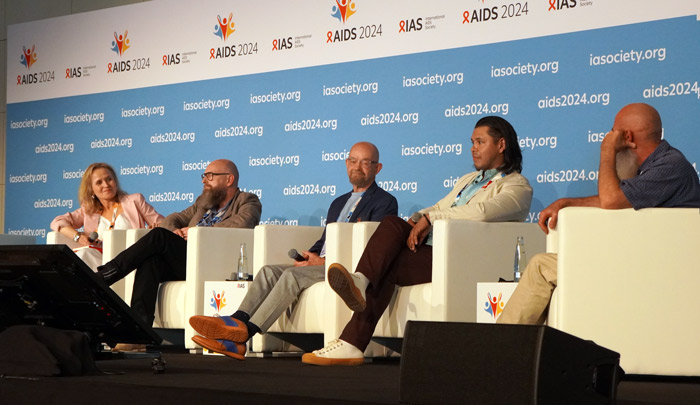

Vice President and Director, TREAT Asia
HIV Science as Art Program
I was selected to be one of 12 scientists paired with 12 artists for the HIV Science as Art program in association with AIDS 2024. A talk I will give at the conference on the integration of mental health care into HIV care helped inform the artwork created by Veronica Betani, and my talk was inspired by Ms. Betani’s experiences as a woman living with HIV who has lived with mental health challenges. Full program here.
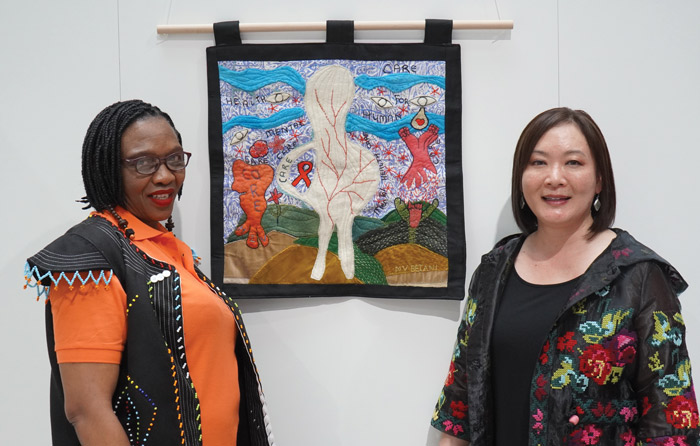
July 20, 2024

Program Communications Manager
Preconference News
AIDS 2024 doesn’t begin in earnest until Monday, but there has been plenty of knowledge and research shared in pre-conference sessions. Today, the Center for Dissemination & Implementation at Washington University in St. Louis organized a series of discussions on implementation science, focusing on the role researchers, policymakers, industry, and academics should play in making sure innovations make it into the hands of those who need it most.
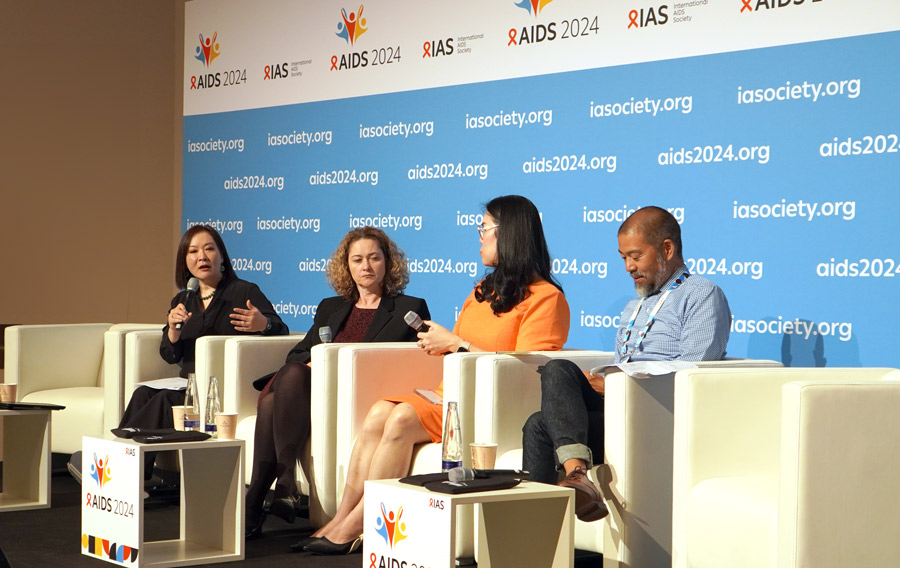
amfAR’s Annette Sohn and Greg Millett both spoke during today’s sessions: Dr. Sohn moderated a discussion featuring effective examples of implementation science, including some from the Tangerine Clinic, a partner of amfAR’s TREAT Asia program, and Millett spoke about changing policy through science-backed solutions.
I was stuck by something ITPC Global’s Solange Baptiste said during one of the afternoon sessions: “Science does not belong to the one wearing the lab coat.” I hope that’s a sentiment we’ll hear repeated throughout the week; as several major breakthroughs including a new HIV cure case and research on long-acting injectables both for HIV treatment and prevention are set to be presented. What good is science for science’s sake? These innovations mean little to the 9.2 million people worldwide who lack access to HIV treatment if they can’t access them, affordably and safely.
And I hope that’s the spirit in which this live coverage will be received. Not everyone can attend the International AIDS Conference—even fewer as fallout from the CloudStrike meltdown has turned almost all chatter at Messe München toward who’s managed to find a flight and who hasn’t—but the discussions are relevant to all of us. I hope that you’ll enjoy, and learn from, the updates amfAR staff will be providing on the ground.
Tschüß for now, more later!
July 17, 2024

Senior Staff Writer
amfAR at AIDS 2024
An estimated 15,000 participants from around the world are gathering to share information and best practices about HIV/AIDS-related advocacy, public health policy, and research at AIDS 2024 in Munich, Germany. Representatives from amfAR and its TREAT Asia program, as well as amfAR-funded biomedical researchers, are participating in over 25 sessions.
Highlights include:
July 24: Jennifer Sherwood, PhD, Director of Research, Public Policy, facilitator at a satellite session, organized by amfAR and Open Society Foundations, titled “Undue influence: The outsized role of U.S policy in global HIV and sexual and reproductive health and rights.”
July 24: Lead investigator Giten Khwairakpam, Program Manager, Community and Policy, TREAT Asia, presenter, “Community-led monitoring goes beyond evaluating essential health components, it also actively addresses issues of rights and social justice in Indonesia and Manipur, India,” which is co-authored by Elise Lankiewicz, amfAR Policy Associate, in a session titled “A tale of two diseases: Novel strategies towards elimination of tuberculosis and viral hepatitis.”
July 24: Greg Millett, MPH, an amfAR VP and Director of Public Policy, invited speaker, “Structural racism and its impact on Black gay men in Europe and America accessing HIV prevention and treatment,” as part of a symposium session titled “Person-centered services: Design and implementation of effective HIV prevention and care.”
July 26: Annette Sohn, MD, PhD, an amfAR VP and Director of TREAT Asia, invited speaker, “Integrating HIV and mental health care: Opportunities for scale-up?,” as part of a symposium session titled “Bridging mind and body: The interconnectedness of HIV and mental health.”